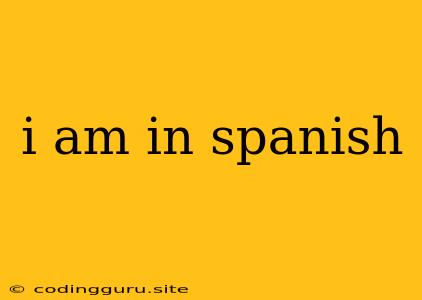"I Am" in Spanish: A Comprehensive Guide
Learning a new language can be an exciting adventure, and mastering the basics like expressing yourself is essential. In Spanish, "I am" is a fundamental phrase you'll use frequently. This guide will break down everything you need to know about saying "I am" in Spanish, including its various forms and when to use them.
The Basic: "Yo Soy"
The most common way to say "I am" in Spanish is "Yo soy". This phrase literally translates to "I am" and is used for most general statements about yourself.
Example:
- Yo soy estudiante. (I am a student.)
- Yo soy de México. (I am from Mexico.)
- Yo soy feliz. (I am happy.)
"Estoy" for Temporary States
While "yo soy" is the most common, there is another important verb you need to know: "estar". It's used to describe temporary states, feelings, or conditions.
Example:
- Estoy cansado. (I am tired.) - This describes a temporary state.
- Estoy triste. (I am sad.) - This describes a temporary feeling.
- Estoy en casa. (I am at home.) - This describes a temporary location.
Key Differences Between "Soy" and "Estoy"
- "Soy": Used for permanent qualities, characteristics, or origins.
- "Estoy": Used for temporary states, feelings, or locations.
Example:
- Soy alto. (I am tall.) - This is a permanent characteristic.
- Estoy de pie. (I am standing.) - This describes a temporary position.
"Ser" vs "Estar" - A Deeper Dive
The verbs "ser" and "estar" are two of the most essential verbs in Spanish. They are often confused, so understanding their nuances is key.
"Ser" is generally used to describe:
- Permanent characteristics: Nationality, occupation, personality traits.
- Origin: Where you are from.
- Essential qualities: What something or someone is fundamentally.
"Estar" is generally used to describe:
- Temporary states: How someone feels or what condition they are in.
- Location: Where someone or something is at a particular moment.
- Actions or activities: What someone is doing.
Examples:
- Soy médico. (I am a doctor.) - permanent occupation
- Estoy enfermo. (I am sick.) - temporary condition
- Soy mexicano. (I am Mexican.) - permanent nationality
- Estoy en el hospital. (I am in the hospital.) - temporary location
- Soy alto. (I am tall.) - permanent characteristic
- Estoy de pie. (I am standing.) - temporary position
Using "I am" with Adjectives
When using "I am" with an adjective, you'll need to conjugate the verb "ser" or "estar" correctly:
"Ser":
- Yo soy + adjective
- Tú eres + adjective
- Él/Ella/Usted es + adjective
"Estar":
- Yo estoy + adjective
- Tú estás + adjective
- Él/Ella/Usted está + adjective
Examples:
- Yo soy feliz. (I am happy.)
- Tú eres inteligente. (You are intelligent.)
- Ella está cansada. (She is tired.)
Mastering "I Am" in Spanish
Remember, "yo soy" and "estoy" are both crucial parts of expressing yourself in Spanish. By practicing using them with different adjectives and situations, you'll quickly become more comfortable using them.
Tips for Learning "I Am" in Spanish:
- Practice regularly: The more you use these phrases, the more natural they will become.
- Create sentences: Make simple sentences using "yo soy" and "estoy."
- Use flashcards: Create flashcards with different adjectives and practice saying "I am" with them.
- Engage in conversations: Find opportunities to practice saying "I am" with native speakers or other learners.
Conclusion
Mastering how to say "I am" in Spanish is an essential step in your language learning journey. By understanding the differences between "ser" and "estar" and practicing using them, you'll be able to express yourself clearly and confidently in Spanish.
